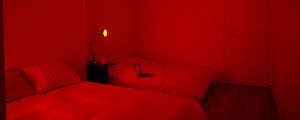The Arts Décoratifs museum is as beautiful as its security guard is intimidating. If you do manage to get through to the entrance hall without being frisked, congratulations. The next challenge is to negotiate your way to the eighth floor where, tucked into the permanent collection “les années 50” (the Fifties), is interior designer Jean Royère’s temporary installation “INTERIEURS DESSINES” (Interior Designs).
It’s not the first time he’s been here. In fact, the museum has a real penchant for the famous avant-garde artist, hosting extensive exhibitions, and even stating – in the way that only French can without sounding daft – that “Le couple Jean Royère / Arts décoratifs s’inscrit dans la durée.” (Jean Royère and Arts décoratifs have been a couple for a very long time, and will continue to be so).

Turning right upon exiting the lift, you’ll find a little room where Les Arts Décoratifs have given Royère his own space to show his pieces. Eight design projects are hung on a vivid violet wall displaying Royère’s gouache and pencil sketches, giving an architectural context to the installation opposite. There’s also a digital screen showing a slideshow of further projects, bringing the artist up to date, whilst a John Coltrane recording from 1963 reminds us of the pieces’ age.
More so than expositions of a more traditional artistic medium, interior design is a collection of individual pieces of art that function as an ensemble, bringing something different when performing together that to when they are displayed individually. There is also the unique requirement of functionality, which could be seen as a constriction to the artistic vision but here we have no sense of restraint. Royère shows his love for texture, comfort and harmony. His pieces are user-friendly, intelligent and fun, which is probably why he became such an international success, with kings for patrons.

Without meaning to state the obvious, the sense of home is very important in this interior. Royère’s pieces form a textured sitting-room, with several of them being created for his mother, including the sofa “Boule” (1947) also called “Banane”. A favourite of mine was the wrought iron light fitting, made using artisanal techniques as with all of the designer’s furniture. Spreading over the wall like ivy, it added to the other organic shapes in the room, creating movement and fluidity but with an urban twist. Interestingly, a small pale blue chair, constructed with wooden jigsaw-shaped pieces, didn’t make it into the official press photo, which is a shame because it was a real little gem.
Were the wooden floorboards a part of the installation? They didn’t match the rest of the exhibition space on floor eight. Either way, it went well with the variety of textures, as did the boat-hole windows and the metal-studded pillars. Royère’s work feels totally at home in, or makes a home of, the space it inhabits.

Despite what I immediately thought of as a muted pop art palette, the color scheme thankfully does not veer towards cliché, but remains deliciously Fifties with rich plums, blacks and acidic yellow-green tones.
Leaving the little corner room with its music, textures and organic movement, there are interesting comparisons to be made with other artists from the same generation. Isamu Noguchi’s pebble flooring and deckchair brings the outside in but perhaps loses out on functionality. Inversely, Jean Prouvé’s minimalist design is all business and purpose.
















